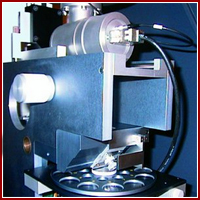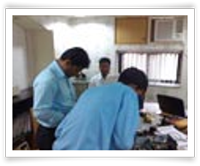TX-2000
TXRF is founded on the same principles of the EDXRF with, however, one significant difference.
In contrast to EDXRF, where the primary beam strikes the sample at an angle of 45°, TXRF uses a glancing angle of a few milliradians.
Owing to this grazing incidence, the primary beam is totally reflected. By illuminating the sample with a beam that is being totally reflected, absorption of the beam in the supporting substrate is largely avoided and the associated scattering is greatly reduced. This also reduced the background noise substantially.
A further contribution to the reduction of the background noise is obtained by minimising the thickness of the sample. A small drop of the sample (5-100 microliters of the substance dissolved in an appropriate solvent) is placed on a silica carrier.
On evaporation of the solvent a thin film, a few nanometers thick, remains. In practice the greater part of the scattering normally arising from the sample and its matrix is eliminated. This is because matrix effect cannot build up within minute residues or thin layers of a sample. Besides its high detection power, simplified quantitative analysis in made possible by internal standard.



 HPLC System
HPLC System  HPLC System
HPLC System  Circular Dichroism Spectrometer
Circular Dichroism Spectrometer
 P-2000 multi-option polarimeter for your laboratory needs.
P-2000 multi-option polarimeter for your laboratory needs. Spectrophotometers
Spectrophotometers  FT-IR instruments and sampling accessories
FT-IR instruments and sampling accessories
 Raman Systems Most Versatile System
Raman Systems Most Versatile System MULTI-PURPOSE AND HIGH RESOLUTION THETA/THETA X-RAY DIFFRACTOMETER
MULTI-PURPOSE AND HIGH RESOLUTION THETA/THETA X-RAY DIFFRACTOMETER








